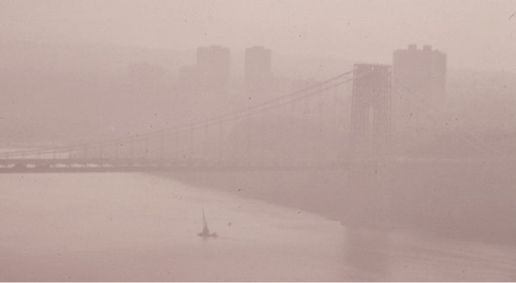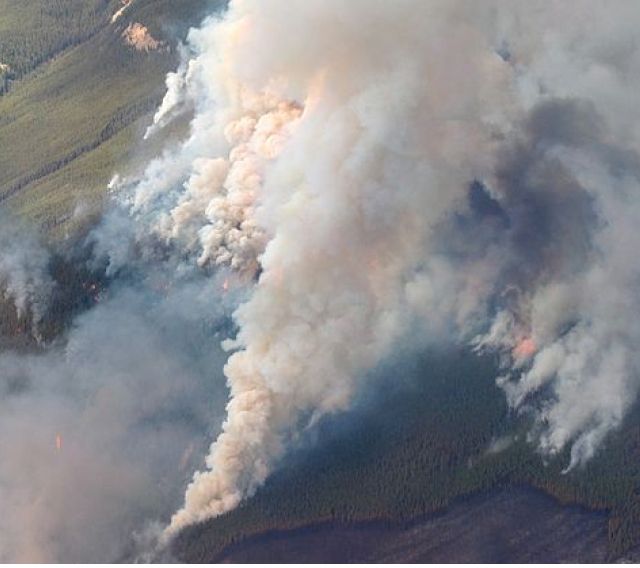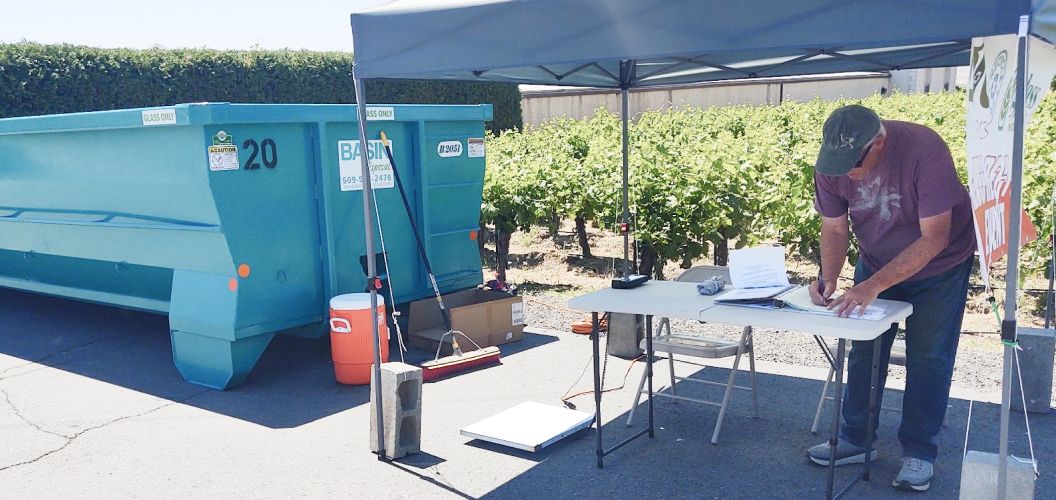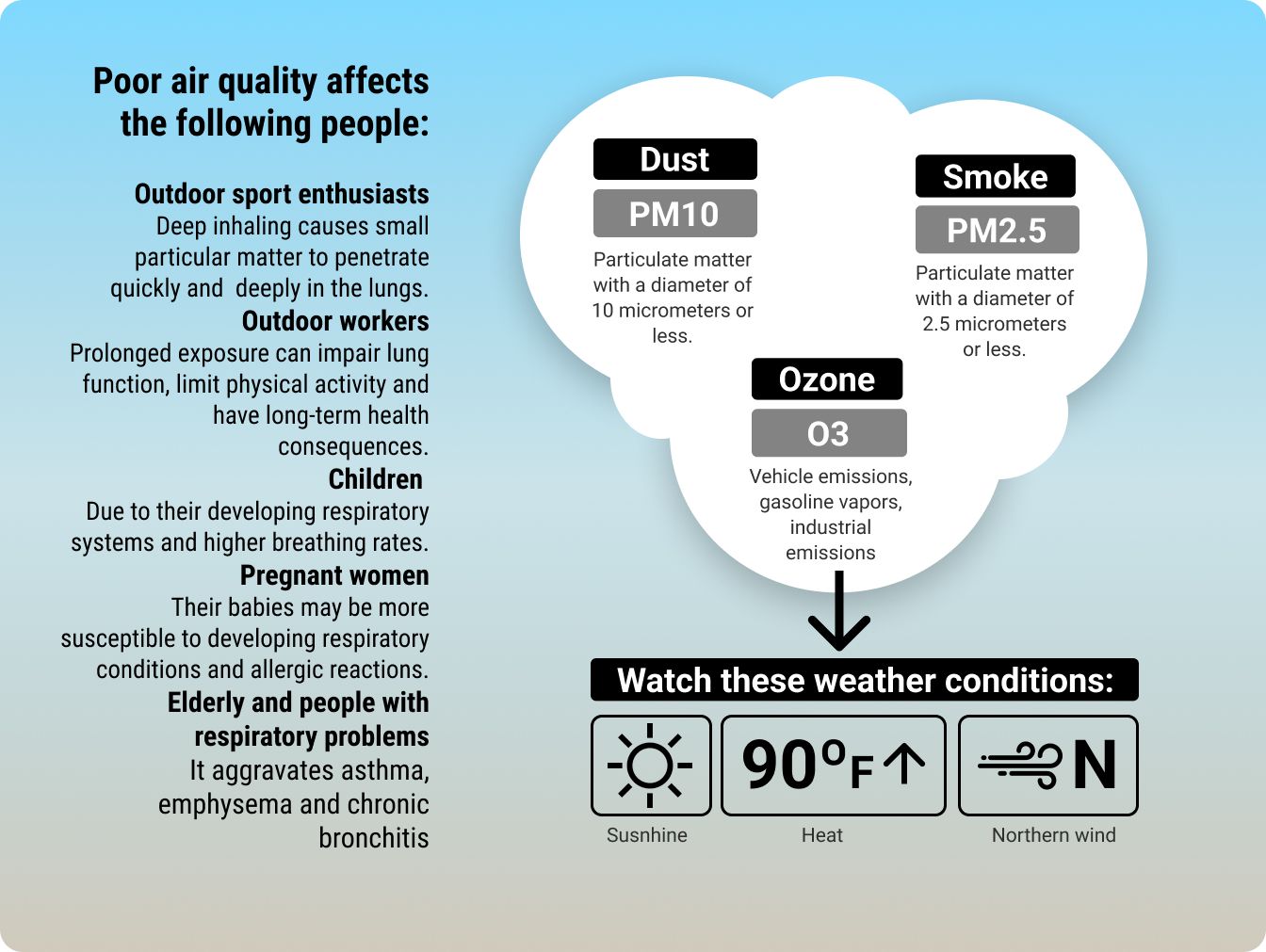This article was triggered by data I found in the 2022 Community Health Needs Assessment — which Tumbleweird published in the December 2022–March 2023 issues — where Benton/Franklin hospitalization numbers of patients with COPD/Bronchiectasis were almost twice as high as the average in Washington state. Further analysis does not show a trend, and there is not enough information to point a finger at the exact cause of these higher numbers; however, my curiosity peaked, and I decided to dig up more information about recent trends related to our air quality.
Dust, smoke, and ozone
According to John Lyle from the Benton Clean Air agency, dust, smoke, and ozone are the top three polluters of our air and are constantly monitored by stations in Kennewick and Prosser.
Although June, July, August are typically months that show high numbers, according to John, there is hardly a reliable prediction to make, due to many different weather variables influencing the air quality.
The Benton Clean Air agency is funded by income from permits, fines, and grants from the state of Washington or EPA, depending on the work needed.
The website bentoncleanair.org provides up-to-date air quality information for residents and businesses, and anyone can send an email to file a complaint.
Are we still an ozone hotspot?
The National Ambient Air Quality Standard (NAAQS) for ozone in the United States is set by the Environmental Protection Agency (EPA) and applies nationwide.
The current standard for ozone is 0.070 parts per million (ppm) as an 8-hour average concentration. This means that the 8-hour average ozone concentration should not exceed 0.070 ppm over a specified time period.
In 2016, a study was conducted for ozone in the Tri-Cities, and a combination of sources (traffic emissions, industrial sources, and agro-chemicals) were described as the potential cause. Even though the numbers were lower than large urban areas like Seattle and Spokane, it was concluded that conditions in the airshed allowed it to “produce ozone efficiently.” This means that if the Tri-Cities were to continue on its growth path, the ozone level would be off the chart.
The conditions that cause ozone are high temperatures and a northern wind which blows against the Horse Heaven Hills, causing air to keep circulating in the lower areas while cooking in the sun.
Since 2016, most years have had multiple days over the EPA’s 0.070ppm threshold, except for 2019, 2020 and 2022 (mostly due to COVID). The worst year was 2017, with nine days in this “unhealthy for sensitive groups” state. It doesn’t look like the trend is going upwards (however, COVID years may have thrown the numbers off). We may be even getting better numbers with more electric vehicles in Tri-Cities in the future.
Ozone over the last 7 years
Below’s data visualization shows daily visual indicators of levels of ozone in parts per million (ppm).

Wildfires, an international problem
Earlier this year, when the Canadian wildfires caused unhealthy air conditions on the East Coast, every New Yorker could feel what we have experienced almost every year during summer months over the last decade.
Besides Canada, our wildfire smoke can also come from Oregon, Washington, and California. John Lyle from the Benton Clean Air agency said that there is an upcoming effort for better “smoke preparedness.” This would include education about how to make sure smoke doesn’t get into your home, how not to exceed the exposure time outside, and using box fans and filters to keep air inside as clean as possible.
“The technology to predict air quality due to wildfires is better,” John said. Follow enviwa.ecology.wa.gov/home/mapcan for updates about air quality conditions.

Burn bans
Burning activities can contribute to the release of pollutants into the air, including particulate matter, smoke, and chemicals. In addition, the vegetation in the area can be highly susceptible to catching fire during a hot and dry period.
There are different restrictions in place for residents and agriculture. Specific bans are publicized on bentoncleanair.org.
“Only residents located outside of the Urban Growth Area are allowed to burn.”
Dust
With an annual rainfall of 6–8 inches, Tri-Cities is located in the most arid part of Washington State.
High winds can raise large amounts of dust caused by agricultural tilling, unpaved roads, or cleared and vacant land.
With many construction sites in the Tri-Cities, John Lyle said that they are actively enforcing regulations on developers to use hydromulch on the land they prepare for new homes or buildings. This is the green cover you see often on cleared construction sites. It turns into a dark yellow color over time.
According to the Benton clean air website: “It is the responsibility of the owner or operator of a source of dust to ensure that dust does not move off property to impact others.”
The enforcement process begins as soon as a complaint is received.
Protect others
To protect others, you can decide to telecommute during the hottest days or use public transportation.
Give outdoor workers multiple breaks or be flexible on the timing of when they conduct outdoor work/services.
Report burn or dust violations immediately by sending an email to the Benton Clean Air agency: contact@bentoncleanair.org
Protect yourself: Prepare!
During the coming months, monitor the Air Quality Index interactive map: enviwa.ecology.wa.gov/home/map
Be prepared to invest in a box fan and attach air filters to it, or buy a fancy air purifier. Make sure your doors and windows are sealed. Order some NIOSH-approved N95 masks and wear them.

“It’s the right thing to do”
Glass recycling kicked off!
June 6 was day one for the new ‘spoke’ (in the ‘hub and spokes’ model) in glass recycling for Eastern Washington. At Hedges Family Estate in Benton City/Red Mountain, Chris Luecke had set up a container with a tent and by the time I was there it was already filled up with wine bottles. It is an initiative from BiG recycling and the Glass Packaging Institute. (See our article from April: The future of glass recycling.)
The initiative is for wineries in the area to participate in reducing the environmental impact of sending perfectly usable materials into landfills.
It functions on a membership basis, and there are tipping fees involved. But according to Chris, these fees are very low and worthwhile “because it’s the right thing to do.”
In principle, anybody can drop off glass, but specific targets are wineries, restaurants, and breweries who can provide large quantities of clean glass. Neighborhoods can do a ‘group collection’ as well, and if cleaned properly, the glass will be happily accepted.
Tri-Cities is being looked at as a possible ‘spoke’ and Chris is looking for proper locations.

Drop off info (clean glass only)
Tuesdays 10am–1pm
Hedges Winery, Benton City
To support a Tri-Cities location or to get on the mailing list:

